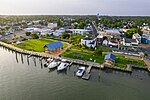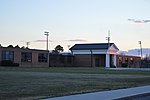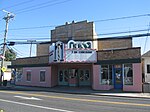The history of human activity in Chincoteague, on the Eastern Shore of Virginia, begins with the Native Americans. Until European explorers possessed the island in the late 17th century, the Chincoteague Indians used it as a place to gather shellfish, but are not known to have lived there; Chincoteague Island lacked suitable soil for their agriculture. The island's name derives from those early visitors: by one popular tale, chincoteague meant "Beautiful land across the water" in their language.
Use of Chincoteague Island by European settlers began in the 17th century, when the island was granted to a Virginia colonist. Legal disputes followed, and it was not until 1691 that title was determined by the courts. Although a few people were living on the island by 1700, it was primarily used as a place to graze livestock. This was probably the origin of the Chincoteague ponies, feral horses that long roamed in the area. They are no longer present in the wild on Chincoteague Island. During the American Revolutionary War, the islanders supported the new nation's bid for independence. The local seafood resources began to be systematically exploited in the early 19th century.
In the American Civil War, the islanders supported the Union despite being located in a seceded state, and the war touched Chincoteague only lightly. Oysters became a major industry in the postwar years. Chincoteague's relative isolation ended in 1876 with the arrival of the railroad at Franklin City, Virginia, across Chincoteague Bay from the island, and the initiation of a dedicated steamboat service between the two settlements. Nevertheless, contemporary visitors found Chincoteague primitive. Part of the island was incorporated as the Town of Chincoteague within Accomack County in 1908; the municipality annexed the remainder of the island in 1989. Road traffic could reach the island with the completion of a causeway in 1922. Two devastating fires in that decade caused the establishment of the Chincoteague Fire Department in 1925; the new volunteer company took over the traditional pony penning, and soon had ponies from nearby Assateague Island swim the narrow channel between the two islands as part of that roundup. The carnival, pony swim, and subsequent auction constitute a highlight of the town's calendar, attracting tens of thousands to the island.
The seafood and poultry industries thrived through much of the 20th century, but neither is important to the island's economy today. Chincoteague is a major tourist destination on Virginia's Eastern Shore, with many coming to enjoy the beaches on Assateague Island. The success of Marguerite Henry's 1947 children's book Misty of Chincoteague and its sequels helped publicize Chincoteague, as did the 1961 film Misty.










